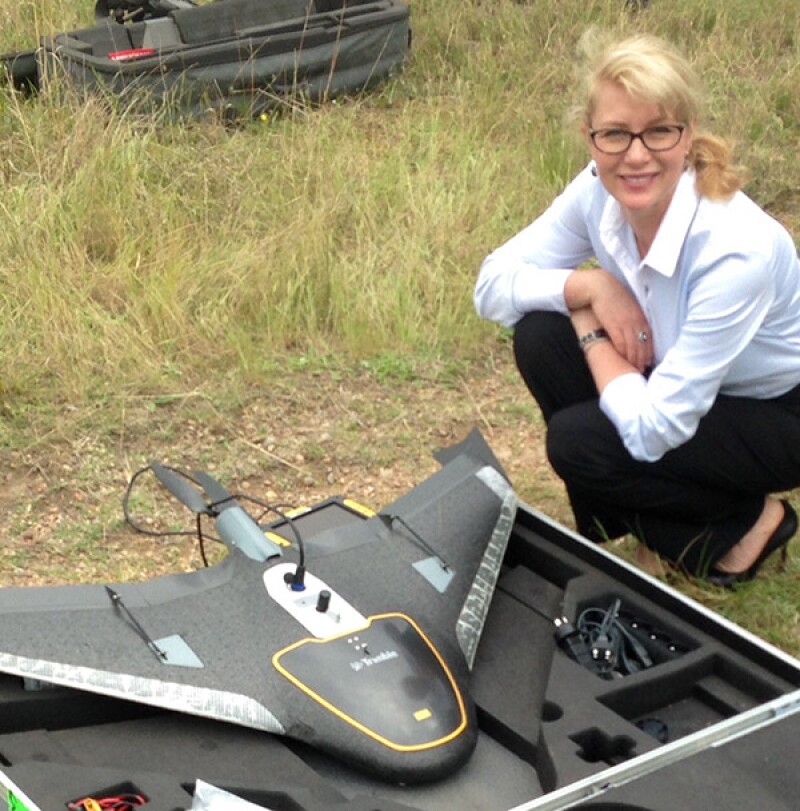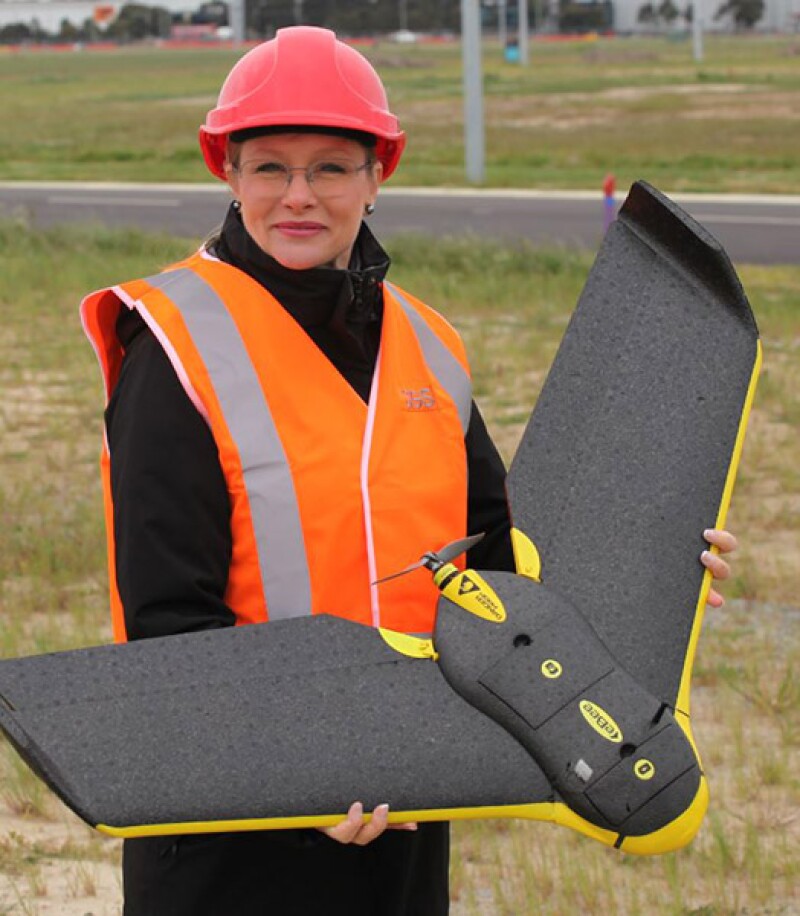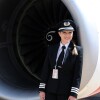TWA's Oil and Gas Careers You Didn't Know Existed series: This series will highlight interesting and diverse career opportunities available in the oil and gas industry, which may not be widely known.
If you have a curious mind and some imagination, your career can take you on an unexpected adventure. After watching the movie Top Gun in the '80s, I filled a sketchbook with intricate sketches of the Lockheed Martin F14 fast jets. I envied "Maverick" and my male school friends who declared that they would become pilots. Looking back, it astounds me that not once did it cross my mind that I could be like those boys—that I could be a pilot. Now my 27 years of being a commercial aviator have left me with a Curriculum Vitae that reads more like an action movie than employment history. Aviation has taken me on wild adventures around the world; from the remote dusty airfields of Australia, to flying movie stars in the pacific islands, auditing helicopter operators in China, airports in Arctic Circle and Alaska, drone operations in Europe, and lobby for the unmanned aircraft or “drone” industry in Washington DC. I attribute some of the best adventures to the day I picked up a drone.
The Drone Industry
Australia was one of the first countries to legislate commercial drone use in 2002, and by 2012 the imminent rise of the commercial drone industry had begun around the world. The first commercial drone legislation was enacted in 2016 by the Federal Aviation Administration (FAA), 14 CFR Part § 107, which superseded the temporary “section § 333” exemption framework. This legislation accelerated the commercial drone boom that was now surpassing the automobile industry's historic boom in the roaring 1920s (Hobbs 2010; Lamb 2017, 2019). Recent data indicated that in June 2019, the commercial drone market size was estimated at close to 6 billion USD globally, with approximately 270,000 drones sold in 2018. Current trends indicate that the Compound Annual Growth Rate will be 56.5% from the period 2019 to 2025, and much of this growth will be in the US (GVR 2019). As of 15 December 2020, there are 514,982 commercial drones, 1,238,411 recreational drones, and 204,796 remote pilots certified drones registered in the US. These can be tracked here.

The commercial drone industry is dynamic. It is characterized by fast growth, a low barrier to entry with minimal requirements for those who want in, and many commercial off-the-shelf technologies available at affordable prices (Lamb 2019). The drone industry is generating previously non-existent career and business opportunities, one example being the burgeoning package delivery industry. This includes delivering medical and consumer goods (Floreano and Wood 2015). The emergent Unmanned Traffic Management System (UTM) is essentially a “sky-highway,” interconnecting drone ports and docking stations for drone recharge and re-loading. Integrating drones into the airspace via these sky-highways requires electronic remote identification and tracking (FAA 2019; Kopardekar et al. 2016). The UTM is a complex and elegant system in development with NASA and industry partners, stimulating an abundance of new opportunities and careers for organizations who use and benefit from commercial drones.
Anti-drone technologies increase in number as there is a need to protect traditional aviation activities, critical infrastructure, and even safeguard human targets from cyber and privacy threats. Drones, like most systems, have life cycle process elements including a) establishing specific system needs, b) the operational concept, c) designing and developing the system, d) producing the system/product, e) deployment of the system, f) operation of the system, g) retirement of the system. and h) if required, disposal of the system (Parnell, Driscoll, and Henderson 2011).
There are costs in every aspect of the Unmanned Aircraft Systems (UAS) lifecycle (Erdman & Mitchum 2013). The long-term cost-benefit estimates produced by the FAA indicate that over the course of 10 years, the net present value is $582 million at a 3% discounted rate with annualized net costs of $68 million. The drone operators will bear the estimated cost of approximately $146 million of this total (FAA 2019). This industry represents vast business opportunities, jobs, new careers, new disciplines, and technologies of the future manifesting today.
Whether you want to fly the drone yourself or manage a team of drone pilots to enhance your functional area, insights from the following expert interviews may give you some inspiration. Your most valuable resource will always be the FAA UAS webpage https://www.faa.gov/uas/. Above all else, it is paramount to consider the risks and safety precautions with as much vigor as you do the benefits and advantages.
Wyatt Filipowicz, Consortiq Wyatt Filipowicz is a skilled and dedicated small UAS Remote Pilot in Command (sUAS, RPIC). He has extensive experience in sUAS industrial inspections, primarily focused on utilities inspections for Southern California Edison, in high-resolution aerial mapping/data collection. He also has experience in post-hurricane damage assessments, tether powered drone traffic surveying, high-resolution mapping, and thermal roof inspections. |
What would you tell young professionals about how they can start to use drones in their “space”?
My first suggestion would be to have a respectful amount of fear of the drone/system you choose but don't necessarily be afraid of it. Get your drone out and fly it. Get enough experience with flying that the controls become second nature. When you can fly it without looking at the remote to see what stick or button needs to be pushed to perform a particular function, you will have mastered that particular craft.
What's the first tangible step they can take to make a career in the drone industry?
The first step I would recommend is to identify your target market, then a need you can fulfill in that market. The service you provide or operation you perform with your drone or unmanned ariel vehicle (UAV) needs to add value for your audience. I personally settled into the industrial inspection market because I understand how critically important it is to the oil and gas industry.
Where can they find more information or opportunities?
I have always found that by following sites like LinkedIn and joining relevant UAV/drone professional groups on Facebook, I am able to keep a finger on the pulse of the industry. As a bonus, I've made a few drone friends too.
Terry L. Duprie, Manager Aviation Operations Support, Exxon Mobil Corp. Aviation Services Terry Duprie started his aviation journey as an avionics technician working on the F/A-18 Hornets. After 4 years, he was commissioned as a naval officer and entered flight training. He spent the remainder of his time in the military as a career naval aviator, flying helicopters (H-3, H-60F/H) and transport aircraft (C-130T, C-40A). In his current role at ExxonMobil, he manages a staff of aviation subject matter experts that includes UAS to offshore helicopters to smaller aircraft for aerial pipeline observation. |
What would you tell young professionals about how they can start to use drones in their “space”?
…[W]e will continue to discover new uses for them [drones] as technology advances, and people learn to utilize these more creatively. They help reduce exposure to human injury. In many cases, they also provide a better product and complete the task in a timelier and more efficient manner. Structural inspections, geological and wildlife surveys, accident/disaster mapping and documentation, emergency response, surveillance, aerial spraying, pipeline patrol, delivery of items, communication, security, and digital video/photography are only some of the uses of drones/UAS.
What's the first tangible step they can take to make a career in the drone industry?
Learn everything you can about drones and the many things they can do. There are many resources available such as online sites/discussion boards and newsletters, trade organizations, university programs, local regulators, and industry professionals. Start small and gain experience. Many of the smaller platforms are at an affordable price point for entry. Get licensed, as it is critical to your success to follow the regulations and industry best practices. As the industry continues to grow and mature, the regulations are constantly changing; therefore, it is very important to stay informed.
Where can they find more information or opportunities?
The incorporation of drones at ExxonMobil started as a natural progression of moving from physically climbing and performing flare stack inspections to utilizing a drone from the ground to complete the task. Initially, drones' use was limited to visual line-of-sight only, which is now changing as the regulatory environment opens. In some locations, they can be utilized for beyond visual line-of-sight tasks as well. This adds value for aerial pipeline patrol and again reduces exposure to personnel and provides improved documentation. Seek out opportunities for internships and entry roles to learn more and to gain experience. Be very familiar with your system's emergency procedures.
Bryce Allcorn, Principal Consultant/Head of Global Operations, Consortiq Bryce Allcorn runs the global operations aspect of Consortiq, managing consulting, training, and unmanned inspection services. Allcorn is a highly experienced remotely piloted aircraft system (RPAS) operator of both rotary and fixed-wing aircraft and was formerly part of the Hampshire Fire and Rescue Service's Aerial Observation team. He is certified to fly commercially in both the UK and the US and holds an Association for Unmanned Vehicle Systems International (AUVSI) TOP-3 Instructor certification. |
What would you tell young professionals about how they can start to use drones in their “space”?
If you have never used a drone or have only GPS experience, buy a tinywhoop or similar small, fully manual UAS. Fly it as much as you can and fly it a distance so you can understand maintaining a visual line of sight. Become good at maintaining a smooth flight; if you get a small manual drone with a camera, fly a stable altitude orbit around a light fitting, record the flights, and replay to see how you can improve.
What's the first tangible step they can take to make a career in the drone industry?
Understand what a business case is, find a template on the internet, and investigate what is required equipment, training, on-going costs, etc. Learn what your market is, what skills you have that using a drone can support, and how you can develop that skill set. Get a mentor.
Where can they find more information or opportunities?
Social media can be helpful but very tricky to navigate and, like anywhere, is full of personalities! If you have an idea of your market sector, look at what resources support that. Contact people in the same field, perhaps a distance away from where you are based, and offer to be a visual observer for free to get experience.
References
Erdman, T. J., and Mitchum, C. 2013. Life-Cycle Cost Analysis for Small Unmanned Aircraft Systems Deployed Aboard Coast Guard Cutters (No. NPS-CE-13-096). Naval Postgraduate School Monterey CA Graduate School of Business and Public Policy.
Federal Aviation Administration [FAA]. 2019. Remote identification of unmanned aircraft systems. Notice of Proposed Rule Making [NPRM, RIN]: 2120-AL31. Washington, D.C.: Federal Aviation Administration.
Floreano, D., and Wood, R. J. 2015. Science, technology and the future of small autonomous drones. Nature, 521 (7553), 460–466.
Grand View Research [GVR]. 2019. Commercial Drone Market Size, Share & Trends Analysis Report by Application (Filming & Photography, Inspection & Maintenance), by Product (Fixed-Wing, Rotary Blade Hybrid), by End-use, and Segment Forecasts, 2019–2025. San Francisco, CA.: Grand View Research. Retrieved from https://www.grandviewresearch.com/industry-analysis/global-commercial-drones-market
Hobbs, A. 2010. Unmanned aircraft systems. In Human Factors in Aviation (pp. 505–531). Academic Press.
Kopardekar, P., Rios, J., Prevot, T., Johnson, M., Jung, J., and Robinson, J. E. 2016. Unmanned aircraft system traffic management (UTM) concept of operations. Presented at the 16th AIAA Aviation Technology, Integration, and Operations Conference. June.
Lamb, T. 2017. Developing a Safety Culture for Remotely Piloted Aircraft Systems Operations: To Boldly Go Where No Drone Has Gone Before. Presented at the SPE Health, Safety, Security, Environment, & Social Responsibility Conference-North America. April.
Lamb, T. 2019. The Changing Face of Airmanship and Safety Culture Operating Unmanned Aircraft Systems. In Unmanned Aerial Vehicles in Civilian Logistics and Supply Chain Management (pp. 243–265). IGI Global.
Parnell, G. S., Driscoll, P. J., & Henderson, D. L. (Eds.). 2011. Decision Making in Systems Engineering and Management (Vol. 81). John Wiley & Sons.
[The article was sourced from the author by TWA Editor Richa Bansal.]


